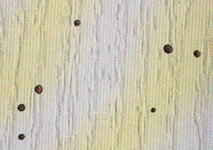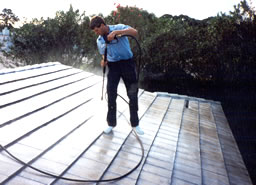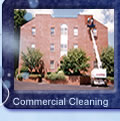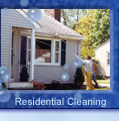Artillery fungus
Artillery Fungus-Sphaerobolus stellatus
 Artillery Fungus, also known as shotgun fungus, is a wood-rotting
variety that prefers sunny, damp areas. It is so small even experts have
trouble
finding it in mulch, but it gives wood a bleached appearance. This particular
type of “mushroom” is a small cream or orange-brown cup containing
a black, round mass of spores. Spore masses are produced when temperatures
are between 50 and 68 degrees Fahrenheit, typical of the spring and fall
seasons. Artillery Fungus, also known as shotgun fungus, is a wood-rotting
variety that prefers sunny, damp areas. It is so small even experts have
trouble
finding it in mulch, but it gives wood a bleached appearance. This particular
type of “mushroom” is a small cream or orange-brown cup containing
a black, round mass of spores. Spore masses are produced when temperatures
are between 50 and 68 degrees Fahrenheit, typical of the spring and fall
seasons.
Click the photo to enlarge
The fruiting body points itself toward strong light sources such as sun-reflecting
glass and light colored buildings and cars. As the body matures, it opens
like a flower, revealing the mass of spores in the middle.
Five hours after opening, the inner cup inverts and violently ejects the
spore mass, with a 1/10,000 horsepower force, as far as 20 feet. The spore
masses, which are sometime mistaken for insect frass, adhere to any surfaces
they contact. Power washing the surface will not remove artillery fungus
as they normally cannot be removed without damaging or staining the surface
and are viable for at least 10 years. Abrasion is about the only method
of removal that works; however you run the risk of surface damage. This
is why we avoid or discourage using abrasion as a means of removal.
To determine if small dot-like discolorations are in fact artillery fungi
perform the following simple test. Take your fingernail and scrape at the
surface of a few dots. If the dark colored top is removed showing a reddish
or lighter color, it is artillery fungus.
The fungus seems to grow on either wood chips or “double shredded” bark
mulch—the dark, organic-looking, thin-stranded mulch. Preliminary
reports indicate that the fungus doesn’t seem to grow on rot-resistant
woods like redwood, cedar and cypress.
Tannic Acid or Cedar Bleed
A major problem facing painting contractors and homeowners is paint failure
and cedar bleed/tanning caused by moisture. The problem is common to houses
of all types and ages, but most prevalent on houses with red cedar shingles
or clapboards.
There are three major symptoms of paint failure due to moisture: blisters,
cedar bleed (or tanning), and rusty nailheads. Blisters can range in size
from inches to feet and may actually have water in them (1). Cedar bleed,
a rusty discoloration, appears in and near the soft and split grain, because
moisture will always follow the easiest way out. Rusty nailheads occur
when moisture, again following the easiest way out, comes past the steel
nail, leaving a rusty discoloration around the head.
The cause: So there's water, water, everywhere, but where is it coming
from? Due to the temperature differential between a home's interior and
exterior, a sweating process takes place and causes a condensation/vapor
to occur in the partitions. The best example is a window on a cold day
without a storm window: You can write your name on the foggy glass. The
contrast between low exterior temperatures and the cozy 68-70F inside causes
water vapor to condense when it hits the cold glass.
Most homes that have paint failure and cedar bleed due to moisture have
forced hot-water heat. (Hot air and electric heat also encounter the problem,
but not as severely.) Usually, the heating pipes are positioned along the
base of the interior on the outside walls on each floor. The water in those
pipes is normally 180F. The differential between the inner walls and the
exterior substrate on a cold night could be 160F to 180F -- which could
continue throughout the six-month heating season. During this time, air
is condensing into a water vapor inside the walls. We saw what happened
to the window at a 68-70F differential, so you can imagine what's happening
between the partitions at a 160-180F differential.
Spring arrives and you open the house to air it out -- end of story, right?
Wrong. All the water trapped behind the substrate wants to get out. The
sun hits the side of the building and acts like a clothes dryer (without
the tumble dry option), drawing the moisture out through the siding. The
surface temperature of siding exposed to the sun for an hour or more in
summer can reach 140F. If the moisture cannot get through the pores of
the paint, it will build up such pressure that a blister will form, and/or
cedar bleed will occur on a stained surface (2).
Moisture problems are most common on areas that are heated and receive
a large amount of sun. Areas shaded by shutters, blinds, eaves, or overhangs
will show little if any paint failure or cedar bleed, since lack of heat
results in the absence or minimization of the drawing effect. Therefore,
the side of the house that rarely sees sun will show less failure due to
moisture. Structures without heat, or attics with louvers, are not subject
to the sweating process, due to the equalization of the temperature on
both sides of the siding throughout the year.
FIBERGLASS ROOF SHINGLE STAINING

Within the past 6 months several areas of your roof have developed a spreading,
dark, mildew-like stain. The climate hasn't changed and there are no trees
that shade your roof. What is going on? Can I easily remove the stain?
Can it be prevented?
You have been invaded by Gloeocapsa magma, a very hardy algae. The streaks
and discoloration is an accumulation of the algae's dead, dark-colored
cells. While this algae can grow just about anywhere in the continental
U.S.A., it prefers humid environments. The algae was probably deposited
on your roof by wind and/or wildlife.
New fiberglass shingles are quite different from your old shingles because
they contain ground limestone, used as a filler to increase the weight
of the shingles.
The algae probably invaded your last roof as well, but it starved to death
because it had different materials; Gloeocapsa magma loves to eat limestone.
This algae can be prevented by introducing copper or zinc, which kills
the algae. These metals are a very effective poison. If your roof is still
quite new, You can install some copper strips as high as possible on your
roof. Rain will wash down small amounts of copper to poison the algae.
Consider installing long, 7-inch-wide strips of copper underneath the last
full course of shingles at the top of your roof. You should be able to
slide the copper up under the shingles approximately 5 inches or so. This
will leave approximately 2 inches exposed to the weather. Some sources
suggest that while this method may work well, in some cases it may be less
than 100 percent effective.)
If you are getting ready to install new shingles, you need not do this.
Many fiberglass shingles are available with colored granules that contain
copper. There are enough granules present on each shingle to kill the algae.
The copper is slowly released over time. Many of these shingles are guaranteed
to kill the algae for the life of the shingle.
Mobile Power Wash of New England has the experience and equipment to safely
clean your roof shingles. Our experienced team will carefully inspect your
roof prior to cleaning to insure cleaning will leave you with desirable
results.
Rust Stains
Rust stains normally are caused by the mineral content in your water supply.
Improperly placed sprinklers which spray against a surface can eventually
cause rust stain problems to develop. Rapid removal is mandated not only
for aesthetic reasons but to avoid permanent staining to the surface. Once
clean, reposition sprinkler heads to avoid restaining. Another possible
cause is from leaching from rusting steel items attached to or adjacent
to the surface. A rusting fire escape, nails and screws are examples of
this. Mobile Power Wash of New England's expert technicians will quickly
remove the stain and make you aware of possible ways to stop these stains
from reoccurring.
| 
















